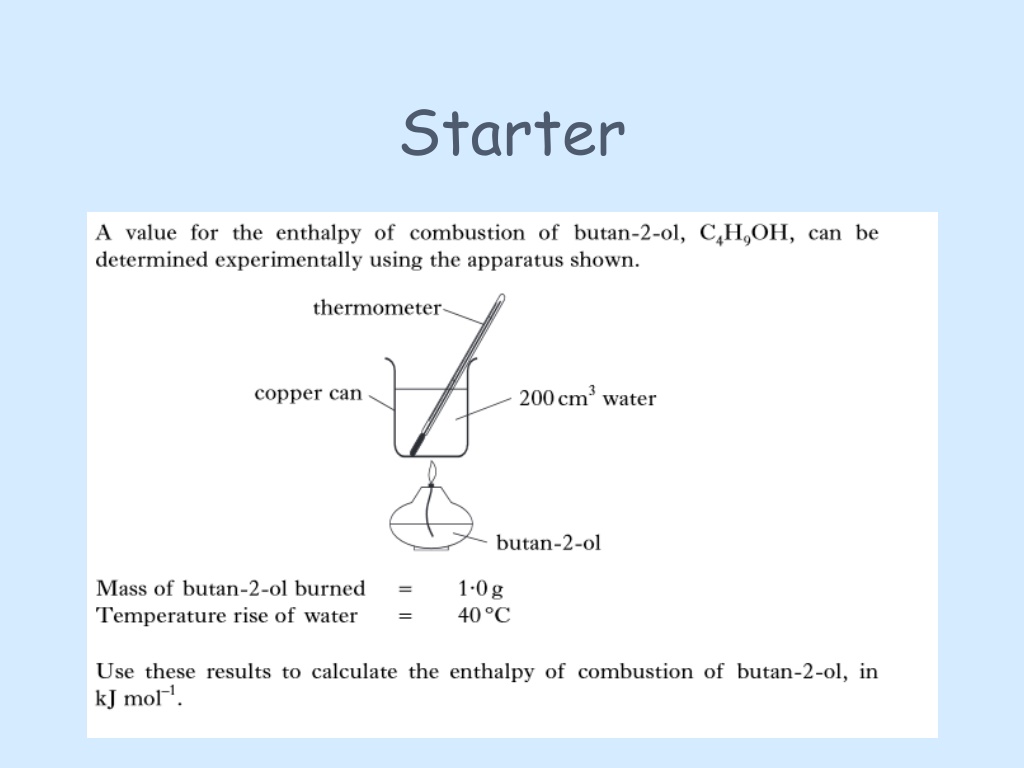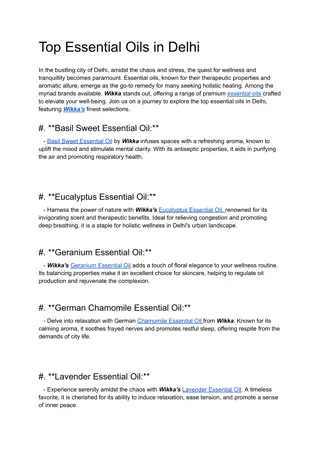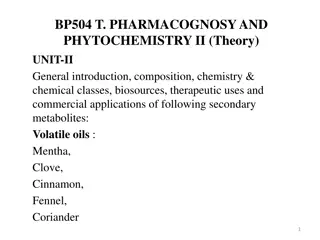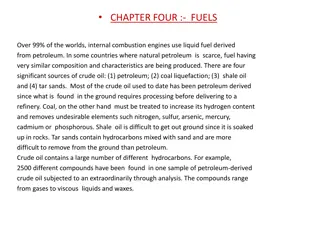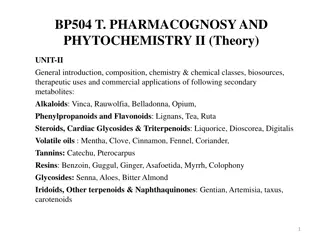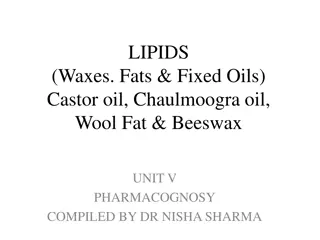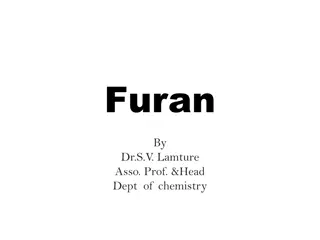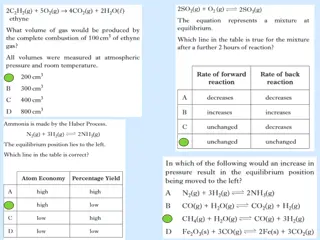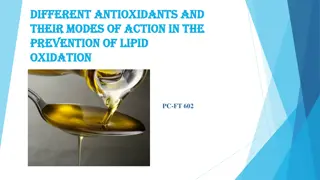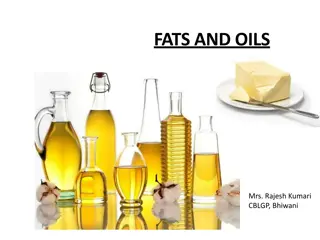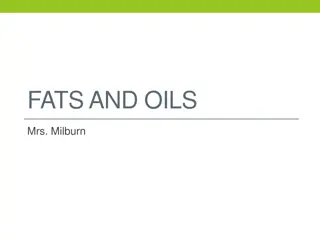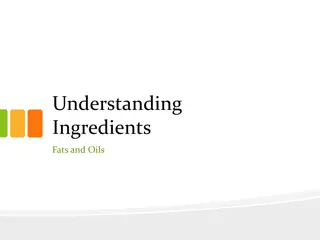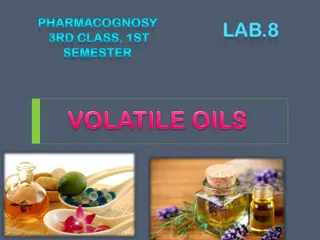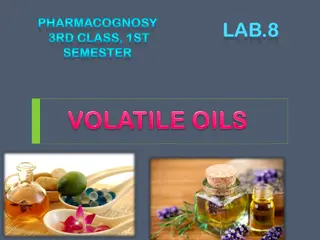Understanding Essential Oils: Properties, Chemistry, and Uses
Explore the fascinating world of essential oils, from their properties and uses to the chemistry behind their distinctive aromas. Learn about terpenes, key components in essential oils, and discover their modern applications in cosmetics, cleaning, flavors, and more. Understand what essential oils are, how they differ from artificial fragrances, and delve into their chemical composition, including esters, aldehydes, ketones, and alcohols. Uncover the role of essential oils in perfumes and cleaning products, with examples like linalyl acetate in lavender and d-limonene in lemon oil. Enhance your knowledge of these natural extracts that have a wide range of benefits in various industries.
Download Presentation

Please find below an Image/Link to download the presentation.
The content on the website is provided AS IS for your information and personal use only. It may not be sold, licensed, or shared on other websites without obtaining consent from the author. Download presentation by click this link. If you encounter any issues during the download, it is possible that the publisher has removed the file from their server.
E N D
Presentation Transcript
Fragrances Overview In this section, learn about the chemistry of essential oils, key components of fragrances. terpenes and
a) Essential oils Learning intention Learn properties and uses of essential oils. about the constitution,
Essential oils Essential oils are the concentrated extracts of volatile, non-water-soluble aroma compounds from plants. Essential oils are widely used in perfumes, cosmetic products, cleaning products and as flavourings in foods.
Essential oils Essential oils are mixtures of organic compounds. Terpenes are the key components in most essential oils.
Modern uses Cosmetics Cleaning Flavours Dentistry Essential oils Adhesives Insect repellents Perfumes Medical
What are essential oils? Essential refers to the fact that the oil carries the distinctive essence (scent) of the plant. Concentrated, volatile, non-water soluble aroma compounds extracted from plants. Contain no artificial substances, unlike perfumes and fragrance oils.
Essential oils chemistry The distinctive character of an essential oil can be attributed to the functionalgroup present in its key molecule. Esters, aldehydes, ketones and alcohols are all found in essential oils.
Essential oils perfume The ester linalyl acetate is found in the essential oil lavender. This ester is often added to perfumes. H3 C C O CH3 O CH3 C CH2 C CH2 H3 C CH CH2 CH Linalyl acetate
Essential oils cleaning The essential oil known as lemon oil contains the terpene d-limonene. It is known for its ability to act as a natural solvent and a cleanser. CH2 C H3 C CH H2 C CH2 H2 C CH C CH3 Limonene (skin of citrus fruits)
Essential oils cosmetics The essential oil geraniol is added to some cosmetics to balance and revitalise the skin. CH3 CH3 C CH2 C CH2 CH OH CH CH2 H3 C Geraniol
Steam distillation Steam distillation is one of the methods used to extract essential oils from plants. Steam passes over the plant and extracts the essential oil. The mixture evaporates and passes into the condenser. The essential oil vapour is chilled and collected.
Essential oils summary Concentrated extracts of volatile, non-water- soluble aroma compounds from plants. Widely used in perfumes, cosmetics, cleaning products and flavourings. Mixtures of organic compounds. Terpenes are the key components of most essential oils.
b) Terpenes Learning intention Learn about the chemistry and uses of terpenes, a key group of unsaturated molecules upon isoprene. based
Terpenes The name terpene is derived from the Greek word terebinth . Terebinth is a type of pine tree from which terpene-containing resins are obtained.
What are terpenes? Natural organic compounds. Components of a variety of fruit and floral flavours and aromas. Used in perfumes, essential oils and medicines.
Spices contain terpenes Terpenes in plants can be oxidised to produce the compounds responsible for the distinctive aroma of spices. Terpenes containing oxygen or other functional groups are known as terpenoids . Common spices containing terpenes include cloves, cinnamon and ginger.
Terpenes are unsaturated Terpenes are unsaturated compounds. All terpenes are built up from units of isoprene.
Isoprene Isoprene is the common name for 2-methylbuta-1,3-diene CH3 H3 C CH2 CH C H2 C C CH2 CH H2 C
Isoprene Head Tail CH2 CH3 = C CH CH2 Isoprene (2-methylbuta-1,3-diene) One isoprene unit contains five carbon atoms
Building terpenes from isoprene Isoprene units can be linked: head to tail to form linear terpenes in rings to form cyclic terpenes.
Myrcene a linear terpene Head Tail Head Tail CH2 CH2 CH2 CH2 C H3 C H3 CH2 H3 C C C CH CH C CH C CH H2 H2 C C H3 C H2 C Myrcene is a component of plants, including bay, ylang-ylang and thyme.
Limonene a cyclic terpene H3 C CH2 C CH H2 C CH2 H2 C CH C CH3 Limonene (skin of citrus fruits)
Menthol a cyclic terpenoid CH3 H3 C This terpene has been oxidised to a terpenoid CH CH OH H2 C CH H2 C CH2 CH See full size image CH3 Menthol (peppermint)
Absinthe a cyclic terpenoid CH3 H3 C This terpene has been oxidised to a terpenoid CH C H2 C CH2 H C C CH O CH3 Thujone (Absinthe)
Camphor a cyclic terpenoid CH3 H3 C C CH CH2 CH2 C H2 C H3 C C O Camphor (Camphor tree)
-Selinene a cyclic terpene CH3 3 isoprene units CH2 CH2 H2 C C CH2 15 carbon atoms H2 C CH C CH2 C CH2 C celery H CH3 CH2 -Selinene
-carotene a linear terpene CH2 H3 C CH2 C CH3 CH3 H3 C CH3 CH2 C CH CH CH CH CH CH C C C CH C CH C CH C CH CH CH CH H2 C C CH CH3 H3 C CH3 CH3 H2 C C -carotene CH2 CH3 169575_1 8 isoprene units 40 carbon atoms
Questions Which unit makes up every terpene? How many carbons are there in an isoprene unit? What is the systematic name for isoprene? What is an oxidised terpene known as?
Answers Which unit makes up every terpene? Isoprene unit How many carbons there are in an isoprene unit? Five What is the systematic name for isoprene? 2-methylbuta-1,3-diene What is an oxidised terpene known as? Terpenoid
Summary Terpenes are unsaturated compounds formed by joining together isoprene units. Terpenes are components in a wide variety of fruit and floral flavours and aromas. Terpenes can be oxidised within plants to produce the compounds responsible for the distinctive aroma of spices.
